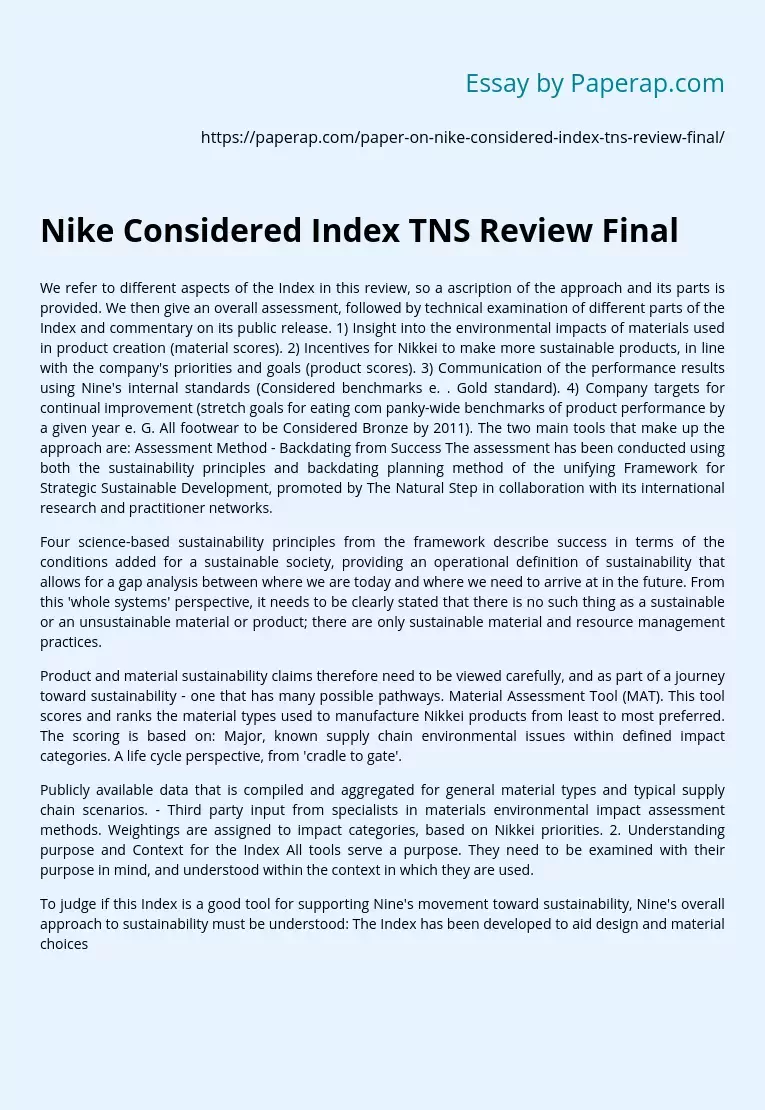Nike Considered Index TNS Review Final
We refer to different aspects of the Index in this review, so a ascription of the approach and its parts is provided. We then give an overall assessment, followed by technical examination of different parts of the Index and commentary on its public release. 1) Insight into the environmental impacts of materials used in product creation (material scores). 2) Incentives for Nikkei to make more sustainable products, in line with the company’s priorities and goals (product scores). 3) Communication of the performance results using Nine’s internal standards (Considered benchmarks e.
. Gold standard). 4) Company targets for continual improvement (stretch goals for eating com panky-wide benchmarks of product performance by a given year e. G. All footwear to be Considered Bronze by 2011). The two main tools that make up the approach are: Assessment Method – Backdating from Success The assessment has been conducted using both the sustainability principles and backdating planning method of the unifying Framework for Strategic Sustainable Development, promoted by The Natural Step in collaboration with its international research and practitioner networks.
Four science-based sustainability principles from the framework describe success in terms of the conditions added for a sustainable society, providing an operational definition of sustainability that allows for a gap analysis between where we are today and where we need to arrive at in the future. From this ‘whole systems’ perspective, it needs to be clearly stated that there is no such thing as a sustainable or an unsustainable material or product; there are only sustainable material and resource management practices.
Product and material sustainability claims therefore need to be viewed carefully, and as part of a journey toward sustainability – one that has many possible pathways. Material Assessment Tool (MAT). This tool scores and ranks the material types used to manufacture Nikkei products from least to most preferred. The scoring is based on: Major, known supply chain environmental issues within defined impact categories. A life cycle perspective, from ‘cradle to gate’.
Publicly available data that is compiled and aggregated for general material types and typical supply chain scenarios. – Third party input from specialists in materials environmental impact assessment methods. Weightings are assigned to impact categories, based on Nikkei priorities. 2. Understanding purpose and Context for the Index All tools serve a purpose. They need to be examined with their purpose in mind, and understood within the context in which they are used.
To judge if this Index is a good tool for supporting Nine’s movement toward sustainability, Nine’s overall approach to sustainability must be understood: The Index has been developed to aid design and material choices as part of Nine’s Considered design ethos, which is part of an overall company sustainability agenda. Nikkei has long-standing commitments to sustainability in place. ; The tool is integrated into Nine’s innovation process. Dedicated personnel support the tool’s development and integration across the organization. The Index connects with, draws from and supports many other aspects of Nine’s sustainable business and innovation agenda (for example, procurement sustainability and audit programs, restricted substances lists, company targets and policies etc). The Considered Index. The Index rewards design innovation choices related to product creation by assigning scores to products.
It encourages the selection of environmentally preferred materials (as scored in the Material Assessment Tool) as well as other practices where the designer can improve the environmental profile of the product, I. . Less waste generation, use of desired chemistry and an innovation bonus for breakthroughs that can be transferred across models. Nikkei uses these tools in a number of ways – for example, aiding procurement decisions, setting of internal standards and more broadly for defining sustainable design performance.
Nikkei has chosen to externally label Silver and Gold standard products, sending a signal to the consumer about Nine’s Considered design ethos. 2 Overall Assessment Using Sustainability as a Driver of Innovation Many traditional tools and approaches for measuring product or eternal sustainability take a static perspective, attempting to measure and assess the scale and severity of known issues and impacts today (primarily a risk avoidance approach).
On their own these life cycle assessment approaches have limitations in terms of guiding strategic decision-making toward 1) sustainable resource management and 2) related business opportunities. Just as an analysis of any single move or piece of sports gear used in a football game cannot tell you who will win, one needs to look at the whole picture. Organizations wishing to use the Index and build from Nine’s experience should bear this in mind and ensure they build the necessary competencies and structures in place to make the best use of the results from the Index.
It is therefore refreshing to see the approach Nikkei has taken combining quantitative material assessment with qualitatively- derived scores rewarding improvements in product creation. This approach highlights an evolution in thinking on measuring sustainability away from solely ‘impact minimization’ and movement toward an ‘innovation enabling’ strategic perspective. We believe this Index is a powerful demonstration of an overall ‘backdating’ approach for enabling sustainable design innovation, not simply a set of tools for measuring movement away from environmental impacts.
Nike Considered Index TNS Review Final. (2018, Jun 19). Retrieved from https://paperap.com/paper-on-nike-considered-index-tns-review-final/

